Greater amberjack (Seriola dumerili) season is opening this Friday May 1-31st and again August 1st– October 31st in Gulf of Mexico state and federal waters here in Florida (regulations here). I thought this would be the perfect opportunity to share some facts about this species, update anglers on the current Gulf of Mexico regulations and a short Identification guide on how to distinguish greater amberjack from lesser amberjack, almaco jack and banded rudderfish. If angling and have and doubt on species identification, it’s always best practice to release the fish and let him see another day.
 Jacks are prized sport fish, providing anglers with some legendary fights! After just a few of them, anglers are often ready to trade in the rod for a break and a beverage. They are voracious eaters and often targeted by recreational, commercial and charter fishermen as they readily accept lures or natural bait in a variety of fishing methods. Greater amberjack are heavily sought after for their sport quality by the recreational fishermen and fillets by the commercial fishermen which puts a lot of pressure on this species! Moreover, it is super important to be able to properly identify which jack is on your line before throwing it in the ice box.
Jacks are prized sport fish, providing anglers with some legendary fights! After just a few of them, anglers are often ready to trade in the rod for a break and a beverage. They are voracious eaters and often targeted by recreational, commercial and charter fishermen as they readily accept lures or natural bait in a variety of fishing methods. Greater amberjack are heavily sought after for their sport quality by the recreational fishermen and fillets by the commercial fishermen which puts a lot of pressure on this species! Moreover, it is super important to be able to properly identify which jack is on your line before throwing it in the ice box.
A Day In The Life Of A Greater Amberjack (Seriola dumerili):
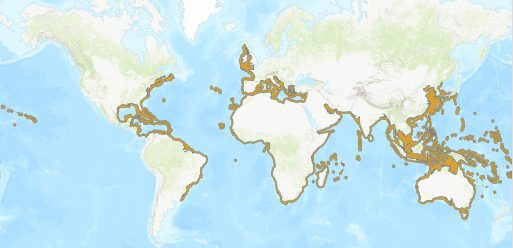
The greater amberjack can be found on offshore reefs and wrecks in the Atlantic and Pacific oceans. Their range in the Western Atlantic is from Nova Scotia to Brazil and typically found in depths between 60-250 ft. This species can grow nearly 6 feet long and weigh up to 200 pounds with females growing larger than males. Greater amberjack can live up to 17 years with sexual maturity occurring between 3-4 years old and roughly 30-50 inches in total length. Amberjack spawn between March through June and during that time a single female can release between 18-59 million floating eggs. Eggs hatch within 34-45 hours and continue to develop as larvae for an additional 31-36 days. Juvenile greater amberjack are yellow in color and have 5-6 vertical bars along their sides. Small amberjack live among floating plants and debris found in the open ocean where they feed on plankton and small invertebrates. As adults, greater amberjack transition to feed on fish and invertebrates that inhabit both pelagic and benthic environments.
The Gulf of Mexico population of greater amberjack is listed as overfished in the 2017 stock assessment while the South Atlantic population is believed to be not overfished. There are now two separate management strategies causing regulations on size and season to differ between amberjack harvested on Florida’s East and West coast. Current regulations for fish caught in the Atlantic are: 1 per person, 28” fork minimum, open year around and in the Gulf: 1 per person, 34” fork minimum, season May 1-31 and Aug 1-Oct 31. The International Union for Conservation of Nature (IUCN) has listed greater amberjack as a species of least concern.
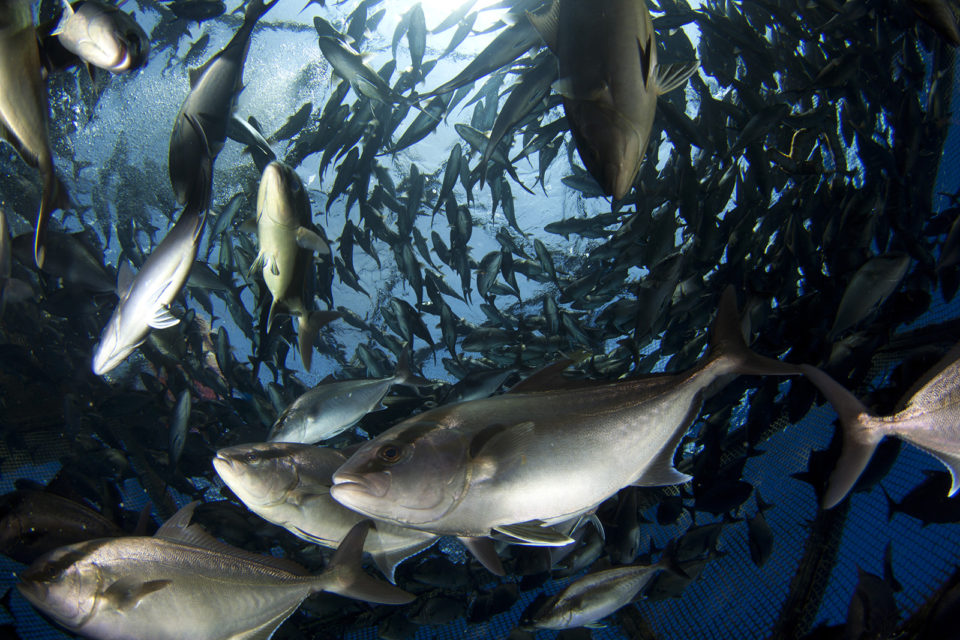
The greater amberjack as well as some other members of the Seriola genus have been successfully bred and raised in captivity. Their fast growth rates and late age of maturity makes them a prime candidate for aquaculture. In fish and many other organisms, growth usually slows once sexual maturity is reached as energy is diverted towards production of eggs and sperm. There is plenty of scientific literature out there regarding spawning and rearing jack belonging to the genus Seriola so give them a read! Due to strict regulations in the United States and efforts by aquaculture operations, amberjack is listed as a best and good alternative fish by Monterey Bay Aquarium Seafood Watch Program.
Spaghetti? I didn’t order Italian?! Tapeworms belonging to the order trypanorhyncha otherwise known as spaghetti worms, can occasionally be found in the fillet of greater amberjack. Jack and other fish are the intermediate host for these cestode worms that undergo an interesting and complex life cycle. The cycle starts within a shark where tapeworm eggs are expelled in the predator’s feces and hatch into coracidium larvae. The tapeworm larvae are consumed by crustaceans (or possibly smaller fish) and change phase into procercoid larvae which wait and hope to be eaten by larger predatory fishes. Once the infected prey is consumed by a predatory fish, the worms transform into plerocercoid larvae and burrow within the muscle, often near the head or the tail portion of the larger fish’s body. The thought of why these worms are so concentrated in near the head and tail is that those areas are usually the first sites bitten by sharks when chomping on a fish. The final desired destination of these worms are inside a shark where they turn into adults, attach to the shark’s stomach or intestines and feed. Spaghetti worms are harmless to humans and can be cut out of the flesh. Amberjack that have been bred and raised in captivity have shown reduced tapeworm infection rates as their diets consists of pellets (more can be read here), this gives seafood consumers a good excuse to support aquacultured jacks! There are some fish parasites that can be transmitted to people so cooking fish thoroughly or freezing to FDA recommendations when eating fish raw should be taken seriously.
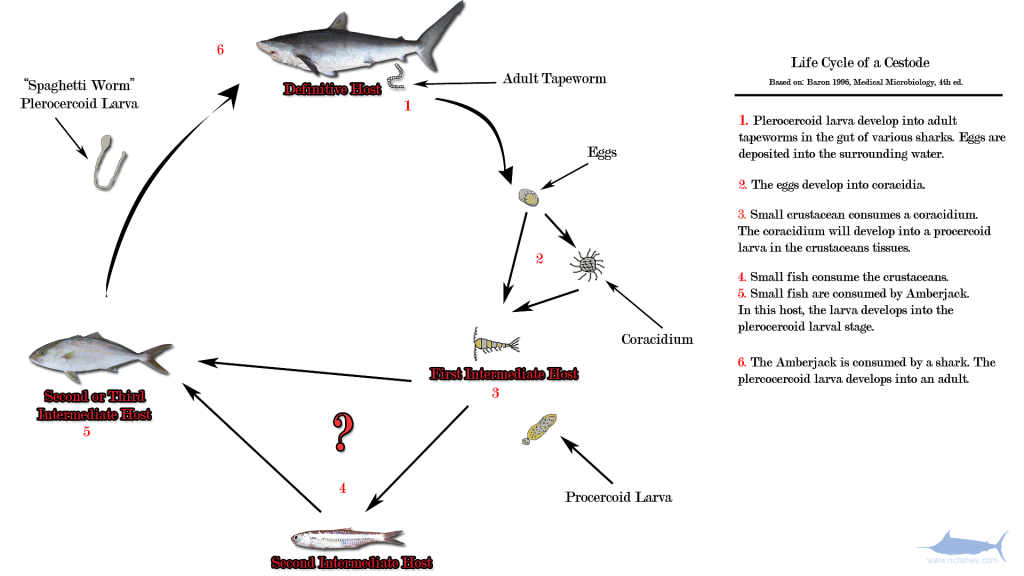
Amberjack have a firmer/steak like flesh that can deliciously be prepared, grilled, blackened or smoked. For an overview on how to smoke fresh fish check out our blog here and video here.

Classification of Amberjack:
Kingdom: Animalia, Phylum: Chordata, Class: Actinopterygii, Order: Perciformes, Family: Carangidae, Genus: Seriola, Species: …
Genus Seriola in Florida:

The genus Seriola contains nine species, four of which are frequently encountered in the Gulf of Mexico. These schooling jacks inhabit offshore reefs and wrecks where they cruise the water column and search for fish and invertebrates. The largest of the four species is the greater amberjack, followed by the almaco jack; the lesser amberjack and banded rudderfish are significantly smaller species and can be similar in size. In Florida, a typical cookie cutter greater amberjack will be in the 20-40 pounds, almaco jack between 2-20 pounds and lesser/banded jacks weighing in below 10 pounds. Size is one criteria to take into account when identifying these species as it would be very very unlikely to encounter a 50 pound banded rudderfish or lesser amberjack, slightly unlikely to be an almaco jack and very likely to be a greater amberjack. The size of these fish can vary greatly throughout the world and along Florida’s 1300 miles of coastline. In Southwest Florida there may be some seasonal size variability with larger jacks moving closer to shore during the winter.
Additional Identification Methods:
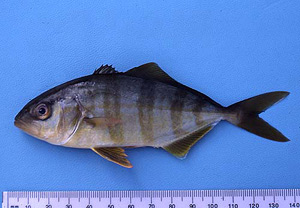
Juvenile versions of these jacks can look different than their adult counterparts and undergo physiological changes as they grow. These changes can primarily be observed in juvenile coloration and pattern. As juveniles, these jacks are lighter in color with vertical bars along the length of the body. The number of gill rakers found on the fish’s gill arch are reduced as these jacks increase in size. Luckily slot and minimum size limits are regulated on all but one of these four species and helps in the prevention of misidentifying undersized jacks.

Using color for species identification gives you a guess but also can be unreliable as color can vary within the species based on genetics, size/age as well as fish activity. One feature that may be more pronounced when the fish is active and “lit up” is the darker colored eye stripe called the nuchal bar. In greater amberjack the nuchal bar starts from the nose and extends into the first dorsal fin area, in lesser amberjack the bar starts from the eye and extends to in front of the first dorsal fin. Banded rudderfish can be more blue-ish in hue as adults and have white tips on their tails. Almaco jack are usually darker in coloration than the other species which is more noticeable when observing the upper portion of the body.
Body shape, fin size/position, jaw maxilla, dorsal spines, keels, gill rakers and more! Body shape is a easy determining factor that can knock of whether you have an almaco or not quickly. The banded rudderfish and greater/lesser amberjacks all have slender bodies, while almaco jacks have deeper shaped bodies that are stretched dorsally and ventrally. Fin position and size can be a good species give away as well. Almaco jack have a elongated second dorsal and anal fin which are proportionally larger than the other three jack species. Compared other three jacks, the banded rudderfish have a shorter anal fin that begins more posteriorly and is only about 1/2 the length of the second dorsal fin. The anal fin for the greater, lesser and almaco jack is about 2/3rds the length of the second dorsal fin on these fish.

Jaw maxilla. The simplest way to describe the maxilla would be the bones that form the top of the jaw and create the corner of the fish’s mouth. Greater, lesser and almaco jack have rounded bump on top of their maxilla near the eye, that portion is called the supra maxilla. This bump resembles a boot and once seen, is hard to un-see! Banded rudderfish have a different shaped maxilla and supra maxilla and is more flat/straight across with no boot/upturned portion. Greater amberjack and banded rudder fish maxilla lengths are also proportionally longer, the bone can extend to be near the middle of the eye but can vary depending on size of the fish. The other two species maxillas will most often end prior to the start of the eye, not extending past the mid section.

Dorsal spines vs rays. On any of these four jack species, the first dorsal fin’s membrane is supported by bony structures called spines. The second dorsal fin however is supported by structures called rays.There are overlaps on number of spines and rays between species but can aid in distinguishing greater from lesser amberjack.

Greater Amberjack: first dorsal fin 7 spines, second dorsal fin 29-34 rays
Lesser Amberjack: first dorsal fin 8 spines, second dorsal fin 28-33 rays
Almaco Jack: first dorsal fin 7 spines, second dorsal fin 27-33 rays
Banded Rudderfish: first dorsal fin 8 spines, second dorsal fin 33-39 rays

One of the more definitive ways of determining which jack you have caught is by checking out the gill rakers. This should be a last resort method of identification as handling a live fish to see their gills can be detrimental to their health. A quick background on the structure of a fish’s gills, a gill can be down into 3 main functional units, the gill arch, rakers and filaments. The arch is the individual gill structure that contains bony comb-like projections called rakers and red gill filaments. The rakers primary function is to filter food and prevent particles from passing through the gills, both to retain food as well as prevent bits from damaging the delicate gill filaments. You can tell a lot about what a fish eats by checking out their rakers, fine close together projections mean that the fish is eating smaller food particles while robust short rakers indicate the fish is eating larger prey items. This can explain why as the jacks grow, the number of gill rakers is reduced as their prey size increases. I’ve seen slight differences in the exact number of gill rakers associated with each species but the general trend/amount is very similar across sources, this may be a result of what stage of life the count is taken. For jacks over 9 inches in fork length the number of gill rakers is as follows.
Greater Amberjack: 11-19 gill rakers
Lesser Amberjack: 23-26 gill rakers
Almaco Jack: 18-25 gill rakers
Banded Rudderfish: 12-17 gill rakers

The portion of the fish where the fin attaches to the body if called the caudal peduncle. The keel is a ridge located on either side of the peduncle and some members belonging to the jack family have pronounced bony projections called scutes. Greater, lesser and almaco jacks at smaller sizes will have more fleshy keels/peduncles while at harvestable size, the banded rudderfish will have a raised and rougher keel. Eye size can be used to determine species but often not as effective if you don’t have another similar sized jack to compare it to. Relatively speaking, lesser amberjack have proportionately the largest eyes of the 4 species while banded rudders have proportionately smaller eyes.
Banded rudderfish and lesser amberjack and small greater amberjack would be the easiest to confuse if similar in size. The regulations of banded rudderfish and lesser amberjack are the same as a result of being so difficult to distinguish. The important thing is not to confuse lesser amberjack with greater amberjack to avoid harvesting an over-slot lesser or an under-slot greater. Remembering that the difference in number of dorsal spines, eye size relative to body, length of nuchal bar and number of gill rakers between these two species can help to avoid misidentification but when in doubt, let him swim!
Greater Amberjack (Seriola dumerili):
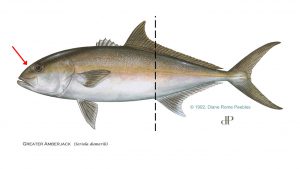 IGFA* World Record: 163 lb 2 oz Japan June 22, 2015
IGFA* World Record: 163 lb 2 oz Japan June 22, 2015
Florida Record: 142 lb 2oz Islamorada, Florida February 3, 1979
2020 Gulf of Mexico Regulations: Daily Bag Limit: 1 per person, Size Limit: minimum 34” fork length, Season: open May 1-31 and August 1- October 31, subject to change if the recreational annual catch target is met
Distinguishing Characteristics: Large slender body shape, 7 dorsal spines, nuchal bar coloration extending into first dorsal area, 11-19 gill rakers.
Lesser Amberjack (Seriola fasciata):
 2020 Gulf of Mexico Regulations: Daily Bag Limit: 5 per person aggregate between banded rudderfish Size limit: slot 14”-22” fork length Season: open all year in state waters, in federal water this species is open all year but may change if the annual catch limit is reached between recreational and commercial landings.
2020 Gulf of Mexico Regulations: Daily Bag Limit: 5 per person aggregate between banded rudderfish Size limit: slot 14”-22” fork length Season: open all year in state waters, in federal water this species is open all year but may change if the annual catch limit is reached between recreational and commercial landings.
Distinguishing Characteristics: Slender body shape, 8 dorsal spines, nuchal bar coloration stopping before first dorsal fin, 23-26 gill rakers, proportionately larger eye.
Banded Rudderfish (Seriola zonata):
IGFA World Record: 5 lb 0 oz Key West Florida April 13, 2015
2020 Gulf of Mexico Regulations: Daily Bag Limit: 5 per person aggregate between banded rudderfish Size limit: slot 14”-22” fork length Season: open all year in state waters, in federal water this species is open all year but may change if the annual catch limit is reached between recreational and commercial landings.
Distinguishing Characteristics: Slender body shape, 8 dorsal spines, anal fin only half the length of the second dorsal fin, white tips on tail fin, rigid keel, flat long maxilla with no boot shape supra maxilla, 12-17 gill rakers, proportionally smaller eye.
Almaco jack (Seriola rivoliana):
 IGFA World Record: 132 lb 0 oz Mexico July 21, 1964
IGFA World Record: 132 lb 0 oz Mexico July 21, 1964
Florida Record: 35 lb 8 oz Destin, Florida October 23, 2016
2020 Gulf of Mexico Regulations: Daily Bag Limit: Florida state waters: unregulated, bag limit 100 lbs per person, Gulf of Mexico federal waters: part of the 20-reef fish aggregate person per day aggregate* Size limit: none Season: open all year in state waters, in federal water this species is open all year but may change if the annual catch limit is reached between recreational and commercial landings.
Distinguishing Characteristics: Deep body shape, pronounced elongated dorsal and anal fin, darker coloration, 18-25 gill rakers.
*The Gulf of Mexico federal water regulation of 20-reef fish per person per day aggregate applies to the following species: vermilion snapper, lane snapper, gray triggerfish, almaco jack, golden tilefish, goldface tilefish and blueline tilefish. The list of qualifying reef species designated by the Gulf Council can be found here.
*Regulations were written as of 4/28/20
*IFGA- The International Game Fish Association
References and Additional Reading Material:
https://www.fishbase.de/summary/Seriola-dumerili.html
https://www.iucnredlist.org/species/198643/115341394
http://sedarweb.org/docs/suar/GAJ_S33_2016%20Update_Final.pdf
http://aquaticcommons.org/12307/1/gcfi_31-23.pdf
http://www.fao.org/fishery/culturedspecies/Seriola_dumerili/en
http://sedarweb.org/docs/suar/GAJ_S33_2016%20Update_Final.pdf
https://www.fisheries.noaa.gov/species/greater-amberjack
https://www.seafoodwatch.org/seafood-recommendations/groups/amberjack?q=Amberjack&t=am
https://myfwc.com/fishing/saltwater/recreational/amberjack/
https://mrc.virginia.gov/vswft/angler_guide/angler_web_guide.pdf
https://ncfishes.com/knowledge-base/amberjack-worms/
https://ncfishes.com/amberjack-identification/
https://www.floridamuseum.ufl.edu/discover-fish/species-profiles/seriola-dumerili/
https://www.charlestonfishing.com/fish-id.asp
https://onlinelibrary.wiley.com/doi/full/10.1111/jwas.12249-
fishrulesapp.com
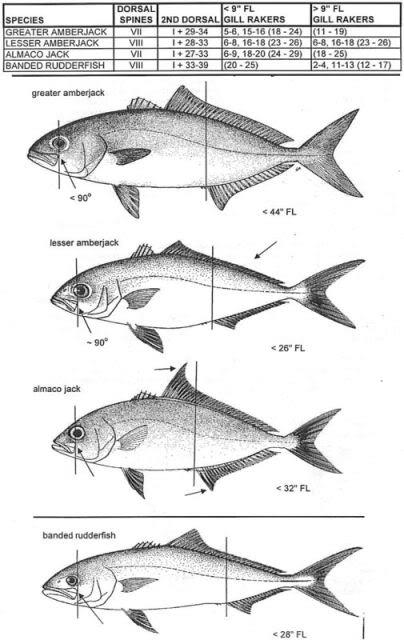
 1
1

Comments:
March 30, 2022
Yes, there is. All information can be found here: https://www.collieredo.org/culinary-accelerator
March 11, 2022
Great comment! I have read that sago palm is susceptible to ganoderma sadly...
February 28, 2022
When folks who have lost a palm to ganoderma here, they usually want something that looks like a palm. Here in Indian River County, I suggest 3 plants which sort-of resemble palms: Sago Palm, which is a cycad but really resembles a plam Ponytail palm, which is not a plam nor a cycad and Pandanus, or "Screw Pine", which is neither a palm nor a pine but a very interesting tropical plant with a very large, interesting round cone-type seed pod when mature and spiraling leaf arrangement.
January 23, 2022
I admire your blog , it has of lot of information. You just got one perennial visitor of this blog!
August 11, 2021
Very, very expensive
June 24, 2021
That's a tricky one as slippers/bulldozers are not as targeted by commercial divers and I don't believe many slippers get caught in regular spiny lobster traps. I would reach out to some local seafood houses to see if they get them in occasionally, request them from a distributor or if they get some of their product by divers, ask if you could make a request or be contacted when they come in. I know a few Tampa area commercial divers and I believe they sell their speared fish to Shelly's Seafood and would check with them https://www.shellysseafood.com/. Good luck!
June 24, 2021
I am looking to buy 20 lb of slipper lobster bulldozer lobster spiny lobster and looking for some place in Tampa area to purchase them
June 1, 2021
I want to give thanks to you for sharing such good information
June 1, 2021
pretty good informative
April 20, 2021
Is there a membership for this program?
March 29, 2021
Hi Earl, I would be happy to take a look at a picture, my email address is sipos624@ufl.edu. Cane toads and other invasive species are usually/can be more common in urban and disturbed areas where the native critters are pushed out leaving an open ecological niche. I did a search of the Everglades Conservation Area 2 A and looks like it backs up to some urban areas on the East side. The FWC promotes reporting sightings of invasive species as the best form of management is early detection and rapid response before the species become established. You could report the sighting on the I've Got One app or on this website (url below), you can also see where some invasive critters have been spotted/reported as well https://www.eddmaps.org/distribution/ . For cane toads they may not mobilize a response as they have been established but researchers could find the information useful and interesting if they are moving more towards rural undisturbed areas. -Mike
March 27, 2021
I got this last night in Everglades Conservation Area 2A. miles from anything dry. It looks like a cane toad and is the size of a bullfrog. secretions from the glands behind the head. if it is a cane toad, and they are reproducing, bad news for natvive glades frogs. i cant figure out how to attach photos but glad to email to you.
January 8, 2021
Great video on sheepshead feeding. Thanks for posting this.
October 30, 2020
Our HOA is requiring residents to hire a tree trimming company to remove the royal palm seed pods ($55 per tree). Do you have any written materials to support nature's "self pruning" of royal palms? The royal palms on our property have never been pruned but the new HOA is determined to excessively prune these palms. Any help would be appreciated. Thank you for your time.
October 1, 2020
I just watched NBC2 news with Twyla Leigh and the Vanilla Bean vine plant. My friend, Dr. Henry Herman, Professor at FSW in Fort Myers, gave me a cutting of his plant and it was amazing how healthy it was and grew to flower. I had moved from that home, but would love to have samples to grow at my home in South Fort Myers. I am a master gardener and would love to help produce more Vanilla Bean Orchid plants. Please contact Twyla Leigh at twlaleigh@ufl.edu
September 24, 2020
I just watched NBC2 news with Twyla Leigh and the Vanilla Bean vine plant. My friend, Dr. Henry Herman, Professor at FSW in Fort Myers, gave me a cutting of his plant and it was amazing how healthy it was and grew to flower. I had moved from that home, but would love to have samples to grow at my home in South Fort Myers. I am a master gardener and would love to help produce more Vanilla Bean Orchid plants.
September 22, 2020
Hi Albrey, The pictures are great! I believe there is a huge value of having real fish pictures for identification. I'm beginning to stockpile photos of distinguishing characteristics for all the species I now catch/do a segment on. I'm trying to do a species profile/fillet video a week on edible fish found in Florida on our Collier County Sea Grant Facebook page https://www.facebook.com/CollierSeaGrant
September 22, 2020
Nice to see you using the helpful species identification clues provided in Fish Rules App. Swipe pics in Fish Rules App to see additional images and identification clues.
June 11, 2020
the internet. You actually know how to bring a problem to light
June 8, 2020
Thank you for your kind words! If there are any invasive species you're interested in particular, I would be happy to answer your questions or put you in contact with an expert within the University of Florida network. Feel free to reach out with any requests or ideas for future programming. Have a good one!
June 5, 2020
This short article was such a good read that will I will definitely recommend it to the friends! The last moment I’ve read some thing as professionally composed was with at https://www.onlinetutorforme.com/portuguese-tutor/. Thank a person for the professionalism and a watch regarding details. Is going to be pleased to read a lot more of your respective writing!
May 11, 2020
Thanks for your info--i didn't realize this was the problem with my porterweed until the plants were quite infected with the caterpillars. I've cut the stems as you suggest...but continually find many I've missed. The infestation is pretty established. What's the best course of action? I've cut back the porterweed substantially, but probably the moths are around and will continue to infect. If I remove the porterweed completely...and start over, must I continually (almost daily) check the plants for infestation? I've had the plants for a few years before the problem occurred.
May 3, 2020
i have a big infestation of this on my native porter weed. Didn't really notice it until it has really devasted my plants an is spreading. It is overwhelming the plants. The caterpiller appears to burrow down inside the stem and then the branch dies. It may be too late for me to control it by just cutting the infected stems out. How do I get these insects under control. Do I need to remove all the porter weed and let the ground remain dormant for a while? I have the infestation in my backyard, but have porterweed in the front also, and I observed early signs of infestation in the front. Would appreciate your advice. So glad you've identified my problem.
January 21, 2020
Thank you so much! Wish so many of my "natives" and Florida friendly, like Wild Coffee, were a bit more cold sensitive. Not sure how I'll have time and ability to protect my 100' hedge row, but we'll give it a valiant try.
January 9, 2020
You're very right about that! We completely agree!
December 27, 2019
I want to give thanks to you for sharing such good information!! North Shore Tree Services
September 23, 2019
Great Share! Hastings Tree Surgeon
August 22, 2019
Cool stuff. Tree Service
December 3, 2018
George, let's set up a time to talk! Give the Extension Office a ring: 239-252-4800 - Jessica
September 21, 2018
Who do I need too talk to the bosses on location??? Am a great talented Chef wanting my own business truck.And knowing dealing Bosses but you. Z And to put healthy great food for the tourists. I leave here for 5years and know know proveries and fisherman.. Gradauted CIAn 2005, like to know permits and costs before I get a food truck please let me know. Best Regards, George Vassilev
September 4, 2018
Hi Seth, the event has already passed. Feel free to call our Collier County Extension Office at 239-252-4800.
August 31, 2018
Hi I want to buy 2 tickets to the Collier county tropical fruit road tour please give me a number to contact someone the link is not working for me. thank you
August 28, 2018
For the royal poinciana caterpillar, carbaryl or a pyrethroid (bifenthrin) should work. Remember just to spray the bole of the tree from the ground up to 3 or 4 feet. No need to spray the canopy as explained in the posted FSHS article.
August 28, 2018
So what do we use to kill them? Seven?
July 18, 2018
Love the pics!!!!
March 15, 2018
Can't seem to be able to sign up for the ag tour. Would like to go, are there any available seats left. Thanks, Joyce Berkoski 239 732 5847
December 8, 2017
I want to compliment Jill for being the Naples face of American Farms. She is innovative knowledgeable and personable. You have a true Gem!
December 6, 2017
We in Iowa followed the hurricane devastation in Naples and its impact on American Farms. Kudos to Alex and the employees for their efforts to rebuild.
Comments are closed.